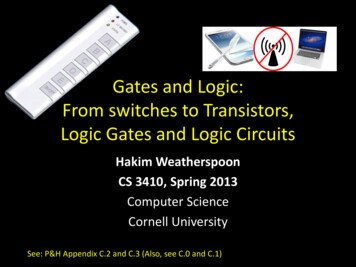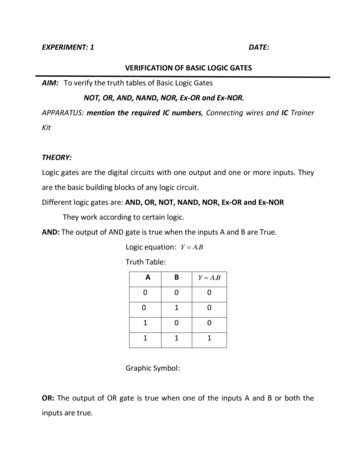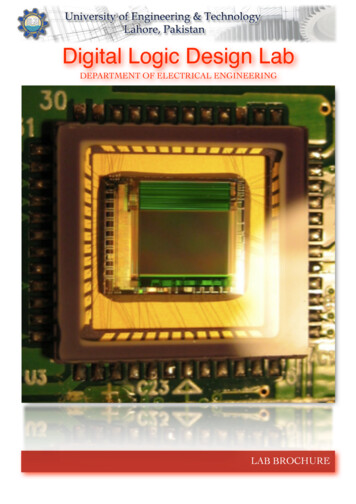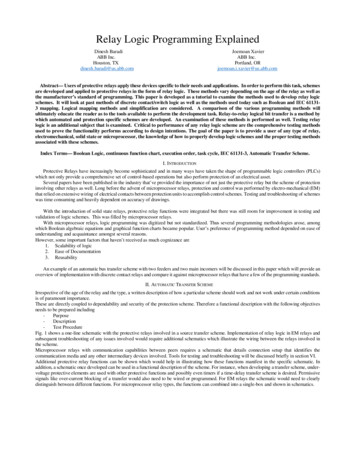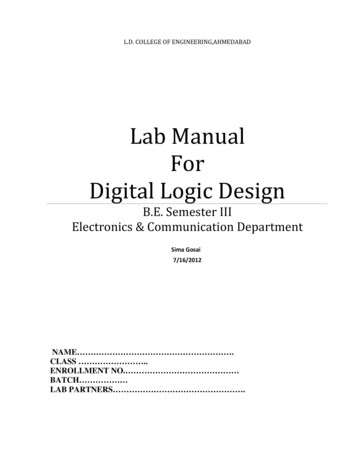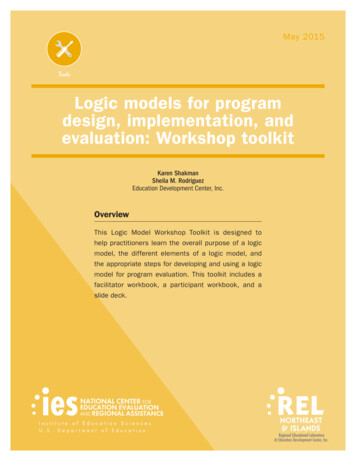
Transcription
May 2015ToolsLogic models for programdesign, implementation, andevaluation: Workshop toolkitKaren ShakmanSheila M. RodriguezEducation Development Center, Inc.OverviewThis Logic Model Workshop Toolkit is designed tohelp practitioners learn the overall purpose of a logicmodel, the different elements of a logic model, andthe appropriate steps for developing and using a logicmodel for program evaluation. This toolkit includes afacilitator workbook, a participant workbook, and aslide deck.U.S.DepartmentofEducationAt Education Development Center, Inc.
U.S. Department of EducationArne Duncan, SecretaryInstitute of Education SciencesSue Betka, Acting DirectorNational Center for Education Evaluation and Regional AssistanceRuth Curran Neild, CommissionerJoy Lesnick, Associate CommissionerAmy Johnson, Action EditorChris Boccanfuso, Project OfficerREL 2015–057The National Center for Education Evaluation and Regional Assistance (NCEE) conductsunbiased large-scale evaluations of education programs and practices supported by federalfunds; provides research-based technical assistance to educators and policymakers; andsupports the synthesis and the widespread dissemination of the results of research andevaluation throughout the United States.May 2015This report was prepared for the Institute of Education Sciences (IES) under ContractED-IES-12-C-0009 by Regional Educational Laboratory Northeast & Islands administeredby Education Development Center, Inc. The content of the publication does not neces sarily reflect the views or policies of IES or the U.S. Department of Education nor doesmention of trade names, commercial products, or organizations imply endorsement by theU.S. Government.This REL report is in the public domain. While permission to reprint this publication isnot necessary, it should be cited as:Shakman, K., & Rodriguez, S. M. (2015). Logic models for program design, implementation,and evaluation: Workshop toolkit (REL 2015–057). Washington, DC: U.S. Department ofEducation, Institute of Education Sciences, National Center for Education Evaluation andRegional Assistance, Regional Educational Laboratory Northeast & Islands. Retrievedfrom http://ies.ed.gov/ncee/edlabs.This report is available on the Regional Educational Laboratory website at http://ies.ed.gov/ncee/edlabs.
ContentsFacilitator workbookIntroduction to workshopSession I. Learning about logic models (2 hours)Session II. From logic models to program and policy evaluation (1.5 hours)Appendix A. Simple logic modelAppendix B. Template for simple logic modelAppendix C. Sample logic model for college readiness programAppendix D. Example of a logic model for an educator evaluation system theory of actionReferences and resources3530A-1B-1C-1D-1Ref-1Participant workbookIntroduction to workshopSession I. Learning about logic models (2 hours)Session II. From logic models to program and policy evaluation (1.5 hours)Appendix A. Simple logic modelAppendix B. Template for simple logic modelAppendix C. Sample logic model for college readiness programAppendix D. Example of a logic model for an educator evaluation system theory of actionReferences and resources3426A-1B-1C-1D-1Ref-1i
Facilitator workbookContentsIntroduction to workshop3Session I. Learning about logic models (2 hours)AgendaPre-assignmentGoalsIntroducing the casesAdditional case examplesWhat is a logic model?Elements of a logic modelAdditional activity: Strategies and activities in sequenceThe logic in a logic modelNext stepsFinal thoughts556789111623262829Session II. From logic models to program and policy evaluation (1.5 hours)AgendaPre-assignmentGoalsExample cases revisitedAdditional case examplesReview of logic modelsIntroducing evaluationMoving from logic model to evaluation questionsGenerating indicatorsBuilding an evaluation designAdditional activity: Data collection frameworkPutting it all togetherReview3030313233343537394348525355Appendix A. Simple logic modelA-1Appendix B. Template for simple logic modelB-1Appendix C. Sample logic model for college readiness programC-1Appendix D. Example of a logic model for an educator evaluation system theory of actionD-1References and resourcesRef-11
ActivitiesI.1 Discussion of casesI.2 Inputs–outputs–outcomesI.3 Problem statementI.4 Focus on outcomesI.5 Intangible resourcesI.6 Uncovering internal and external assumptionsI.7 If-then statementsI.8 Next stepsII.1 How will you know?II.2 Formative and summative evaluationII.3 Generating questions for different audiencesII.4 Generating indicators of the fluII.5 Process and outcome indicatorsII.6 Consider data sources1015171924252728374042434549Table1 Traditional audiences, evaluation questions, and uses412
Introduction to workshopA logic model is a visual representation of a theory of action or program logic guidingthe design and implementation of a program or policy and can be used as a tool for build ing a relevant evaluation design. The Regional Educational Laboratory (REL) Northeast& Islands administered by Education Development Center created this workshop to helpgroups, such as the research alliances affiliated with the 10 RELs, as well as individualalliance members, learn about and build logic models to support program designs and eval uations. Based on feedback from alliance members, REL Northeast & Islands learned thatmany of its district- and state-based members would like to build their capacity to developlogic models for both evaluating their own programs and working more effectively withevaluators whom they engage to conduct evaluations on their behalf.This workshop provides a primer on logic modeling and demonstrates how to use logicmodels as a tool for program evaluation. The overarching goals of the workshop are to: Introduce logic models as an effective tool for program or policy design, implemen tation, and evaluation. Practice the elements of a logic model. Provide guidance in appropriate steps for building a logic model for a program orinitiative. Practice using logic models to develop evaluation questions and indicators ofsuccess. Provide guidance in how to determine the appropriate evaluation for a specificprogram or policy.Versions of this workshop were presented to three REL Northeast & Islands research alli ances in 2013 in two different formats. The Puerto Rico Research Alliance for DropoutPrevention participated in a three-hour face-to-face workshop focused on supporting thealliance’s effort to generate a common vision for dropout prevention work. The UrbanSchool Improvement Alliance and the Northeast Educator Effectiveness Research Alli ance both participated in virtual webinars for a broad audience of practitioners interestedin developing skills and capacity to develop and use logic models to increase individualand group capacity to design and evaluate programs.This toolkit provides a complete workbook and slide deck for two sessions. Session I is 120minutes long, and Session II is 90 minutes long. The first session focuses on the elements ofa logic model and the process for developing a logic model for a program or policy. Thesecond session provides guidance on how the logic model can be used as a tool to developevaluation questions and indicators of success. While the workshops are designed as90-minute to 2-hour sessions, there are many examples of ways to extend the activities andthe learning when more time is available to go in depth on any particular aspect of thematerials. These recommended extensions are denoted with a light bulb ( ). The bulk ofthese recommended supplemental activities are best for a face-to-face workshop ratherthan a virtual workshop. However, in many cases guidance is provided on how to approachthe activity in a virtual context.The authors thank the following people from Education Development Center, Inc., for their expertise andresources in developing these materials: Katrina Bledsoe, Leslie Goodyear, Brian Lord, and Anne Wang.3
There are 13 notes in session I and 13 notes in session II that focus on supplemental activ ities and the recommended extensions.There are also pre-assignment activities that participants are encouraged to completebefore the start of the workshop.The toolkit includes items needed to successfully present this workshop in a face-to-face orvirtual setting: Facilitator workbook for sessions I and II. Participant workbook for sessions I and II. Slide deck for sessions I and II (available at http://www.relnei.org/tools-resources.html).It is recommended that the presenter be familiar with logic models and have some famil iarity with the content that participants might apply to the skills presented in the work shop. Whenever possible, the facilitator should provide examples that are relevant to theaudience for the workshop (for example, for an audience of school administrators, considerexamples relevant to their particular work contexts and how they might use a logic modelin their work).Some initial suggestions for tailoring: Organize teams of school-, district-, or state-based leaders to attend together, andfocus on a particular program or policy. Across contexts, focus on a particular type of program or policy, such as dualenrollment (high school and college dual enrollment), educator evaluation, orother particular policies or programs relevant to the participants. A pre-assignment is provided at the beginning of the workbook. It is recommend ed that participants have access to the workbook in advance so they can completethe pre-assignment in preparation for the workshop. The slide deck that goes with the workbook can be modified to increase relevancefor the participants. For example, if the group is focused on career and technicaleducation, examples could be modified to be more relevant to this content area.This material can be challenging for some audiences, and the times suggested are basedon an experienced facilitator using the toolkit. Therefore, it is important that facilitatorsknow their audience. Facilitators new to logic models may want to first practice using theworkbook and slide deck and become familiar with the purposes of the exercises and deter mine the appropriate pace of the session.4
Session I. Learning about logic models (2 hours)AgendaThe times here are suggestions, based on 120 minutes for session I. Adjust these times to suityour setting, format, and focus. A face-to-face workshop may have some extension activities, asdescribed throughout this document, and will therefore be longer than 120 minutes.5 minutesIntroduction and goalsFacilitator offers introductions followed by an overview of the agenda and purposes ofthe workshop.10 minutesIntroducing the casesFacilitator reviews cases that will be used as examples throughout the workshop.Activity I.1 (7 minutes): Participants brainstorm the goals of the programs in the casesand the types of questions that might be appropriate to ask about the cases.20 minutesWhat is a logic model?Facilitator introduces logic models as a useful tool for program design, implementation,and evaluation. Facilitator then introduces three types of logic models with threedifferent purposes. Facilitator discusses overall idea of inputs-outputs-outcomes thatdrives logic model development and the logic of logic models.Activity I.2 (10 minutes): Participants complete an inputs–outputs–outcomes table forthe College Ready case.65 minutesElements of a logic modelFacilitator walks through all elements of a logic model. Several individual elements havean associated activity. Problem statement: Includes discussion of what a problem statement is andthe questions that need to be considered in developing an appropriate problemstatement.Activity I.3 (7 minutes): Participants brainstorm their own problem statements. Outcomes: Includes discussion of short- to long-term outcomes and impacts, aswell as review of what outputs are and how they differ from outcomes. Guidance forgenerating outcomes is provided.Activity I.4 (15 minutes): Participants fill in a table that helps generate outcomes for theirown examples or for one of the case examples. Strategies and activities: Focuses on program components and how sequencing andclustering of activities should be considered. There is no workshop activity associatedwith this element, but there is an activity in the workbook provided as a suggestion forparticipants to do on their own following the workshop. There is a brief pause here forquestions. Resources: Discusses material and intangible resources.Activity I.5 (7 minutes): Participants brainstorm at least five nonmonetary resourcesavailable to them in a program. Assumptions: Discusses examples of assumptions and the importance of beingexplicit about assumptions.Activity I.6 (10 minutes): Participants brainstorm internal and external assumptions fortheir program or initiative.10 minutesThe logic in a logic modelFacilitator discusses the if–then statements that are embedded within logic models.Facilitator then walks participants through the logic of the if–then statements in theblended learning case.Activity I.7 (7 minutes): Participants practice with the College Ready case and order aseries of if–then statements.10 minutesNext stepsFacilitator closes with discussion of some next steps for developing a logic model and areminder of how logic models can support program design and evaluation.Activity I.8 (5 minutes): Participants indicate a next step for their work.5
Pre-assignmentConsider a program or policy that you lead or are actively involved in designing, imple menting, or evaluating. Come to the session with the following materials or information: For whom is the program or policy designed? What are the main goals or objectives of the program or policy? What is the timeline and duration of the program or policy? What are the major activities or strategies associated with the program or policy?Program or policy:For whomMain goalsor objectivesTimeline anddurationMajor activitiesor strategiesFor a face-to-face workshop, invite participants to spend a few minuteswriting notes about a particular program or policy on the worksheet, ifthey have not done so prior to the workshop. Then have them talk toanother participant about the example they selected. In particular, askthem to address the questions: For whom is the program or policy designed(and who benefits from the program or policy)? What are the main goals orobjectives of the program or policy? If there is time, have them also answerthe question: What are the major activities or strategies associated withthe program or policy? This pair activity extension will add 15 minutesto the overall time for session I. It may be useful to send the participantsthe workbooks before the workshop along with the pre-assignment so thatthey can come to the workshop prepared for this discussion.6
GoalsSupporting materials for this section: slide 4.Session I of the workshop will: Introduce logic models as an effective tool for program and policy design, imple mentation, and evaluation. Invite participants to practice the elements of a logic model. Provide guidance in appropriate steps for building a logic model for a program orinitiative.7
Introducing the casesSupporting materials for this section: slide 5.This section describes the two cases that are used as the examples throughout the work shop (and provides some additional case examples that may be used if more relevant to theparticular audience). These examples are based on real programs or policies. These casesprovide a common language for discussing all aspects of the logic model. Participants mayalso want to draw on their pre-assignment, in which they generated their own example, touse throughout the workshop.College readiness high school programCollege Ready is a school-based college access program for students in grades 9–12. Stu dents are identified for the program based on eligibility for free or reduced-price lunch,recommendations from school guidance counselors, and recommendations from grade 8English and math teachers. Students participate in monthly meetings as a group with theCollege Ready staff, are provided with one-on-one counseling with College Ready staff,are assigned an adult mentor and a peer mentor, and participate in a series of evening andsummer workshops. In addition, families make a commitment to the program and attend aseries of workshops specifically designed to prepare the whole family for the college appli cation process. The goal of the program is to significantly increase college attendanceamong low-income students.Blended learning schoolsAn urban district is going to convert a few of its schools into blended learning schools(in which students learn both online and face-to-face with a teacher to personalize theirinstruction). The schools will be using the individual rotation model, which allows studentswithin a given course or subject to rotate on an individually customized, fixed schedulebetween online courses and a variety of classroom environments with face-to-face teach ers. Individual students have their own netbook and a unique schedule. The model alsoincludes site coordinators and a principal who is involved in daily classroom observation.The goal of the model is to improve student achievement and individualize instruction.8
Additional case examplesThree additional cases are provided below. Any may be useful for illustrating the key ideasin this workshop, and all the cases may be drawn on to explain the concepts embedded ina logic model. The cases above were used to support a workshop focused on programs mostrelevant to urban schools, and the first two cases below were used to support a workshopfor practitioners focused on educator effectiveness initiatives. The final case was used inthe workshop with the Puerto Rico Research Alliance for Dropout Prevention. In addi tion, if this workshop is being designed for a group of educators focused on a particularissue, such as English learner students, consider developing an additional case relevant tothe participants.Redesigning a district’s educator evaluation processA school district wants to review and update the teacher evaluation process that it hasused for more than 10 years. The new system must reflect the new state guidelines for eval uation, which include a requirement for multiple measures, including a student-learningmeasure. However, much is left to the district to determine: How decisions will be made,what measures will be used, who will conduct the evaluations, and how the evaluationprocess will be managed and supported. The district has determined, in keeping with stateguidelines, that the new evaluation will assess teachers’ professional practice and theirimpact on student learning. The district leadership would like the system to be supportedby teachers, to effectively differentiate among teachers, to support teachers’ ongoing pro fessional growth, to lead to improvements in teacher practice, and ultimately to positivelyinfluence student learning.Professional development initiative for science teachersA state department of education is implementing a new professional development programfor science teachers in secondary schools that focuses on promoting inquiry-basedapproaches. The state will partner with informal science partners, such as museums, andwith industry and will develop a series of content courses for teachers. The professionaldevelopment will use research-based materials and practices so that teachers can build adeep foundation of knowledge that will allow them to grow professionally. In addition,districts will create professional learning communities and ongoing science instructiondevelopment opportunities to support inquiry approaches. There will also be profession al development offerings that focus on leadership development to support coaches, leadteachers and principals, and curriculum directors in science learning. The goal of thisprogram is to enhance teachers’ knowledge in science, increase student participation inscience courses, and increase student learning and achievement.Universal prekindergarten policyMassachusetts has implemented a policy to provide prekindergarten education to all chil dren through a blend of private and public providers. According to Early Education for All,70 percent of three- and four-year-olds in Massachusetts attend a formal early educationand care program. The challenge is to ensure that the programs they attend are highquality ones, because as decades of research document, only high-quality prekindergartendelivers lasting benefits, particularly for low-income children.9
Activity I.1: Discussion of cases Individually.Working on your own for about two minutes and using the worksheet below, consider theCollege Ready or blended learning case above. What are the goals of the program? What mightwe want to know about it? Consider questions of implementation, effectiveness, and impact. In large-group discussion.What are your ideas about the goals of the program and what do you want to know about it?What are the goals ofthe program or policy?What do we want to know aboutthe program or policy?For a face-to-face workshop, consider adding a teamwork component toactivity I.1, in which the participants discuss one of the cases above insmall groups. Consider allowing people to select their own case to focus onor divide them into groups to discuss one or more cases. Then ask partici pants to briefly share the goals and some of their questions. This discussionwill add 15 minutes to the overall time for session I.10
What is a logic model?Supporting materials for this section: slides 6–9.This section provides a primer on logic models, including different types of logic modelsand their potential purposes.In the most basic terms, logic models provide a kind of map for a program or initiative,helping clarify a program or policy’s destination, the pathways toward the destination, andmarkers along the way.Consider: Where are you going? How will you get there? What will tell you that you have arrived?Logic models provide a simplified picture of the relationships between the program orpolicy inputs (resources, strategies, activities) and the desired outcomes of the program.Logic models present a theory of action or change that drives the program or policy andmakes explicit any assumptions about both the resources at the disposal of the programand the rationale behind the effort.A logic model is valuable in supporting: Program planning. Program implementation. Program monitoring. Program evaluation.Why use a logic model? A logic model: Brings detail to broad goals. Helps identify gaps in program logic and clarify assumptions. Builds understanding and promotes consensus. Makes explicit underlying beliefs. Helps clarify what is appropriate to evaluate and when. Summarizes complex programs for effective communication.A logic model is useful in designing program and policy evaluation, because a logic modelhelps clarify both what the program, initiative, or policy is and what it is not. This kind ofclarification is helpful in building an evaluation design that can capture the program’s orpolicy’s influence and impact.What are the limitations of a logic model? A logic model is not: A strategic or fully developed plan for designing or managing a program or policy. An evaluation design or evaluation method.While logic models are useful tools for building program plans or evaluation designs, addi tional work is necessary to create both programmatic and evaluation plans.11
Types of logic modelsNot all logic models are the same, nor are they designed for the same purpose. Just as logicmodels may aid in program design, implementation, and evaluation, the type of modeldeveloped varies somewhat based on its purpose. There are three main types of logicmodels: Theory approach. Activities approach. Outcomes approach.Theory approach modelsLogic models that describe the overall theory of change provide a “big picture” of theprogram and may be useful for program design and overall communication of the programtheory. These models provide a clear description of why the developers believe the programor policy will be effective in achieving the goals. In the blended learning case, a theoryapproach logic model might help clarify the assumptions implicit in the push for alter natives to traditional brick and mortar classrooms and describe the relationship betweeninitiating blended learning and the expected outcomes for students who participate.Consider: What might be the logic in a theory approach model for your own program orpolicy? (The “big picture” theory of change about your initiative?)Activities approach modelsActivities approach models focus on laying out the specific strategies and activities associ ated with a program. These models closely examine the relationship among the activities,considering sequence and timing of implementation, as well as how the activities link tooutcomes. This type of logic model is most useful in program implementation, monitor ing, and management. In the College Ready case, this type of logic model would consid er the elements of the program and how they would be optimally ordered and managed.For example, what role would the different mentoring components have? How would theyrelate to one another? In this type of model, relationships among variables are made explic it with arrows, concentric circles, and other graphic representations of relationships.Consider: Why consider the sequence and relationship among activities in a logic model?How might that help you?Outcomes approach modelsOutcomes approach models are most useful for program evaluation. They consider thestrategies and activities as they relate to the desired results of a program or policy. In thesemodels, the focus is on outcomes, and they often divide the outcomes into short-term out comes, long-term outcomes, and impacts. A theory of change drives these models just as itdoes the others. But in an outcomes approach logic model, the emphasis is on examiningthe outcomes and making the case that the program or policy is responsible for the desiredoutcomes.12
Consider: Why divide outcomes into short term and long term? What is the differencebetween outcomes and impacts?For a face-to-face or small virtual workshop that has the option for par ticipants to discuss, the “consider” questions could be posed for discussionamong the whole group or among small groups. This will add 10 minutesto the overall time for session I. If less time is available, these questions canbe run through quickly or referenced without discussion, as they are notessential to understanding a basic logic model.Inputs–outputs–outcomesSupporting materials for this section: slides 10–14.In its simplest form, a logic model is a graphic representation of the relationship among aprogram’s or policy’s inputs (what is invested in the program), the outputs1 (what is donewith these investments), and what the outcomes are (what are the results).Take a simple example: You have a headache and you want it to go away. What is the input?Quiet time.Water.A hot compress.Two aspirin. What is the output (that is, what do you do with the inputs)?Sit quietly for five minutes.Drink a full glass of water.Put hot compress on.Take aspirin. What is the outcome?You are more relaxed.You are hydrated.Your headache goes away.You are able to return to your work.1. The use of the term “output” here differs from its use when outputs are included as a specific elementin a complete logic model. The use here is in terms of the general inputs–outputs–outcomes logic ofa logic model. In this case, outputs do not refer to the measurable, targeted activities that are actuallycompleted; rather, they refer more generally to what is done with the inputs to achieve the out comes—that is, as one part of the overall logic embedded in a logic model. While possibly confusing,the main idea here is that a logic model sets up a logical progression from resources to activities tooutcomes. The section that discusses the specific elements of a full logic model separates strategiesand activities from outputs.13
Below is an example from the blended learning case. Some base inputs, outputs, and out comes have been laid out, reflecting the overall logic of the program.InputsOutputsOutcomes Existing technologyinfrastructure Technology integration staffperson for three schools Teachers’ enthusiasm in threeschools Technology integration grant Infrastructure audit completed Completion of six days ofsummer teacher professionaldevelopment Six blended learningclassrooms established Teachers’ reported use ofdiverse instruction strategiesincreases Student engagement increases Student achievement ondistrict-wide assessmentsimprovesTo extend the activity in a face-to-face workshop, after presenting theheadache example, ask participants to think of another example. Orsuggest the example of the problem being a house on fire. Then ask themto consider the inputs, outputs, and outcomes associated with solving thatproblem. Allow them time to generate some ideas on a piece of paper andthen ask them to provide some examples. This will add 10 minutes to theoverall time for session I. Here are some possible answers: Inputs:Ladder.Hose with water.Firefighters.Outputs:Firefighters climb the ladder.Firefighters spray water on the fire.Firefighters bring the people down the ladder.Outcomes:The fire stops.The people are saved from the fire.14
Activity I.2: Inputs–outputs–outcomesUsing one of the example cases (College Ready), consider the inputs, outputs, and outcomes.This activity helps illustrate the basic purpose and premise of logic models, but what is gen erated is not an actual logic model. Rather, this activity is designed to help you understandthe overall logic undergirding logic models. For more information on the elements
A logic model is a visual representation of a theory of action or program logic guiding the design and implementation of a program or policy and can be used as a tool for


